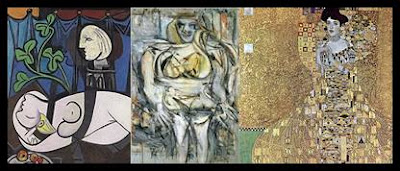When Syed Haider Raza moved home from Paris to Delhi last December, it was a monumental decision for him. Personally, it meant the artist was giving up a city that had made him an internationally recognised artist.
Professionally, the only surviving member of the four top-selling masters of modern Indian art was shifting back to the land of his inspiration at a time when the other great of this quartet, MF Husain (1915-2011 ), had quit the country due to controversies.
Art watchers know well that any movement in the lives of Husain and Raza always came loaded with possibilities as the two, along with FN Souza (1924-2002 ) and Tyeb Mehta (1925-2009 ), commanded - and continue to command - 50-60 per cent of the total Indian art market.
Though there is no established monitor for Indian art - with the field relying mostly on independent estimates by various agencies - a majority of the experts agrees that the Big Four hold more than half of the total market. The market itself is valued at anywhere from $100 million to $ 400 million (roughly Rs 1000-1600 crore).
This is, however, a finite market, as Husain, Souza and Mehta have passed away. Mehta, anyway, was not a prolific painter and created only about 200 canvases in his lifetime though it was his 'Mahishasura' that had first crossed the million dollar mark when it fetched $1.54 million at a Christie's auction in September 2005. Husain and Souza were productive but the frequency with which their canvases will come into the market will depend on the collectors who hold them.
True to form, in less than a year after his shift from Paris, Raza mounted an exhibition of his latest works, 'Punaraagaman' (Return), in Delhi recently. Given the gestation period that each painting has to go through before it becomes hot property, the paintings may not immediately set the auction world afire. But they are important in a market that is beginning to expand beyond Mumbai, Delhi and overseas where 90 per cent of it is located.
Ashish Anand of Delhi Art Gallery, who had hosted the most ambitious show of the Progressive Artists earlier this year (Souza, Husain and Raza were founder members of this group and had blazed a trail by giving an Indian identity to modern art), says, "An established collector would aim for paintings from Raza's best phase from the past. But for those who have just got acquainted with art and want to possess one of the top signatures, these new paintings are important as older Raza paintings don't come up easily in the market. That's significant for Indian market if it wants to expand."
The Indian art market that has come under sharp focus ever since it started growing rapidly in the early years of the last decade is highly lopsided - the collector base is of just about 500, largely located in two cities. That's ridiculous if it wants to make a dent internationally like China has done. The Chinese art market is 40 times that of India's.
If the market has to grow, it will soon have to expand base to newer territories. Art watchers hope that as Tier II and III cities acquire more money power, art will find takers beyond Mumbai and Delhi. Sapna Kar of the India Art Collective initiative, whose online art fair, the first in the country, concluded last evening, says, "I have received queries from Hyderabad, Surat and Gaya. The database of Indian collectors is not more than 500 in number. How much art will an individual consume? A big chunk of the future of Indian art lies in smaller cities where the people have the money to buy art but no exposure yet." Menaka Kumar-Shah, the Mumbai-based head of New York auction house Christies, cites the example of collectors in Coimbatore who are beginning to set up art institutions.
Another big push that Indian art would soon need is in the form of non-Indian foreign buyers. Dr Hugo Weihe, who heads the Indian and Southeast Asian Art department at Christies, New York, says, "At one of our sales last year, a Husain canvas was picked up by a non-Indian American buyer for $1 million plus, and there is a lot of interest in Indian art by Chinese and Indonesian buyers at our ongoing Hong Kong sales. This curiosity will help Indian market to grow."
But even as the market grows and embraces new collectors, a demand for canvases by the big four continues to remain high because anybody with enough money to buy top-end art wants to own a Husain, a Raza, a Souza or a Mehta. The enduring popularity of the super sellers had even survived the recession with aplomb, taking a dip initially but recovering quickly. The November 2011 report on the state of the Indian art market by London-based analyst ArtTactic also says market experts remained strongly positive about modern Indian art though the overall ArtTactic Indian Art Market Confidence Indicator was down by 28 per cent from April 2011 due to a drop in confidence in the Indian economy by 69 per cent.
Maithili Parekh, director, Sotheby's India, says that it is the historicity of modern masters - a term that would also include, besides the top four, artists like Jamini Roy, the Tagores, VS Gaitonde, Akbar Padamsee, Ram Kumar and a few others - that makes them so attractive. "They forged a new identity for Indian art with their path-breaking work when a newly independent India was seeking its own identity. They captured the strong political and social influences of the time beautifully," says Parekh. Arun Vadehra, Christie's consultant in India who also heads the Delhi-based Vadehra Art Gallery (and host of Raza's latest exhibition), adds that buying a canvas by a top-end modern master is like buying "a piece of history."
As Published in the Times of India
Profile of S.H Raza







